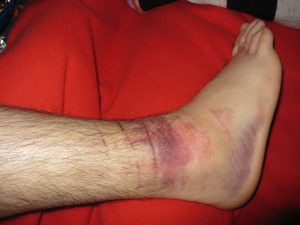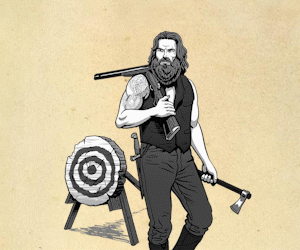If you’re like the average American, you are not getting the recommended 2.5 hours of moderate activity each week. That’s 2.5 hours where you’ve got your heart rate up and your breathing is fast but not quite out of breath. For these people (including me here); when we get the urge to be more active by playing ball with the guys, working off some extra holiday weight, running after kids at the park, showing off for a significant other, or taking up a new hobby; injuries are more common. As the sprain and strain are the most common of these injuries, let’s cover how they happens and what to do.
Sprain Treatment
A sprain and strain are not quite the same things. A sprain affects ligaments and strains affect muscles and tendons. The mainstay treatment of any sprain-type injury is RICE.
Rest – You want to avoid using the injured part as much as possible. For an ankle, avoid putting weight on the leg and use crutches if at all possible.
Ice – Use a cold compress or ice pack for 20 minutes at a time as much as every hour if desired. You can make your own out of a frozen wet cloth or sponge in a plastic bag wrapped in a towel. Keep doing this as much as you can for the first 48 hours to keep any swelling to a minimum.
Compression – Use an elastic bandage or neoprene brace to support the joint and help limit swelling
Elevation – Finally, as much as possible, keep the limb above the level of your heart. Stack pillows or couch cushions up to make a support, even while sleeping. This will help alleviate swelling.
*Disclaimer #1: RICE does not apply to back injuries.
Medication
NSAID (nonsteroidal anti-inflammatory drugs) medication like ibuprofen or naproxen will also help limit swelling and pain with your injury. You can also alternate NSAID’s with acetaminophen to increase pain relief. Just make sure you follow the directions on the bottle. This applies to all sprains and strains.
Ankle Sprain
 This is likely to happen if your leg or body shifts while your foot is planted (common in sports like soccer and basketball), or if your foot rolls with weight on it (stepping in a hole on uneven ground). In these cases, your pain comes from ligaments (fibrous bands that support your ankle) getting stretched or torn. You may experience swelling, pain, and with more severe cases even bruising and an inability to put weight on the foot. With the most severe ankle sprains, it can be very difficult to tell it apart from a broken ankle without an x-ray…you’ll definitely want to go to the urgent care if there is immediate swelling, bruising, and/or an inability to walk.
This is likely to happen if your leg or body shifts while your foot is planted (common in sports like soccer and basketball), or if your foot rolls with weight on it (stepping in a hole on uneven ground). In these cases, your pain comes from ligaments (fibrous bands that support your ankle) getting stretched or torn. You may experience swelling, pain, and with more severe cases even bruising and an inability to put weight on the foot. With the most severe ankle sprains, it can be very difficult to tell it apart from a broken ankle without an x-ray…you’ll definitely want to go to the urgent care if there is immediate swelling, bruising, and/or an inability to walk.
Back Sprain and Strain
This is likely to happen if you’re reaching out or up while twisting (common in your weekend pickup basketball game), or lifting while twisting (playing with children and packing/moving). The pain comes from the ligaments, tendons, or muscles in your back being stretched beyond what they should be. You may experience swelling, tension (knots), and pain with moving. This generally doesn’t need to be seen by urgent care unless the pain lasts for more than 7 to 14 days with treatment, or if you’re having numbness, tingling, or burning down one or both legs. If you have bowel, bladder, or sexual dysfunction that is new after the injury you definitely need to go to urgent care.
The first step for a back sprain and strain are the same. Rest it by using your back less (don’t lift anything too heavy and don’t twist and lift). During the rest period, add gentle stretching so the muscles don’t get tight. My recommended search terms online are “stretches for back pain” or “yoga for back pain”. You still want to ice your back as often as you are able, too. If you find the ice is uncomfortable, after the first 48 hours, of course, you can change to heat. Icing during the first two days is very important to minimize the amount of swelling and prevent further injury. Compression is out, as limiting your movement with a brace or with bed-rest has actually been shown to slow healing. You also can’t exactly elevate your back above your heart without standing on your head all day.
Make sure you go over to Part 2 to read about Overuse Injuries.
Final Disclaimers
MING and the author, Daniel Hardy, are offering generalized medical information for educational purposes. For health information about specific personal conditions, please see a local professional familiar with your needs. Do not start or stop a medication without a doctor’s advice, and only start an exercise regimen if healthy enough.











